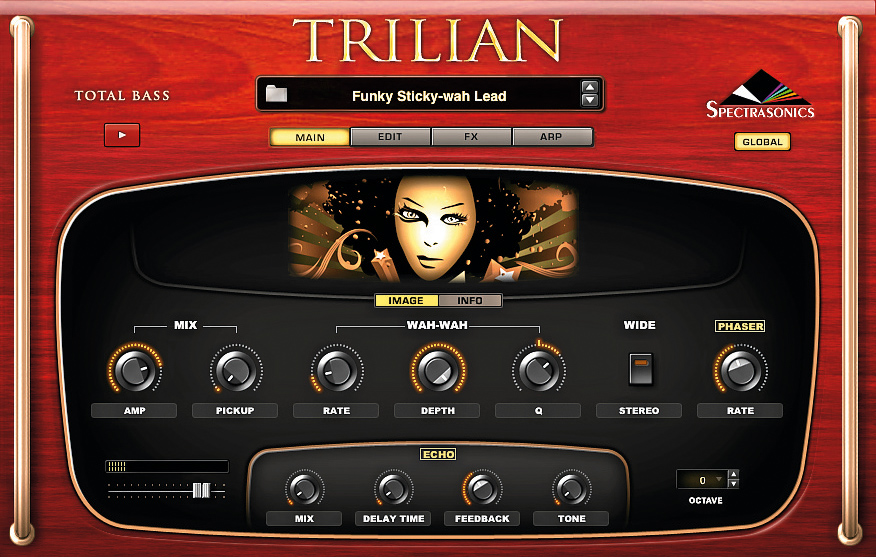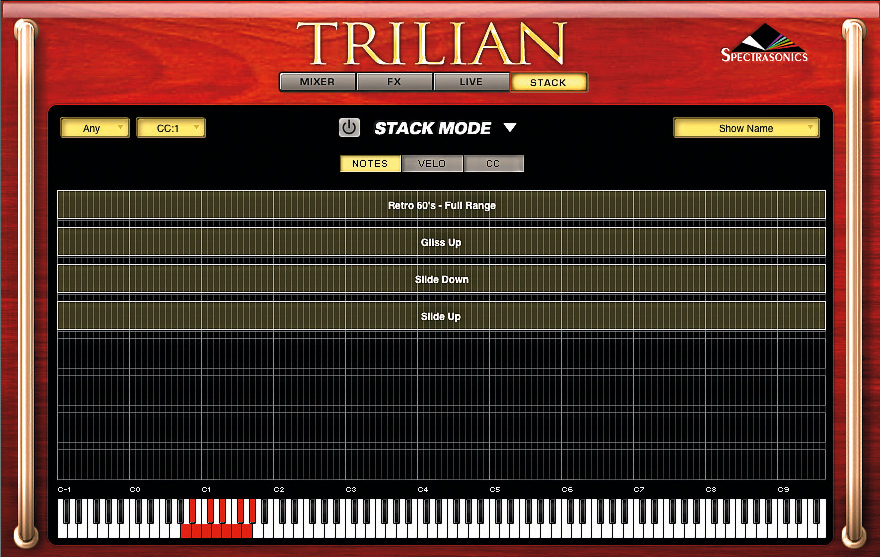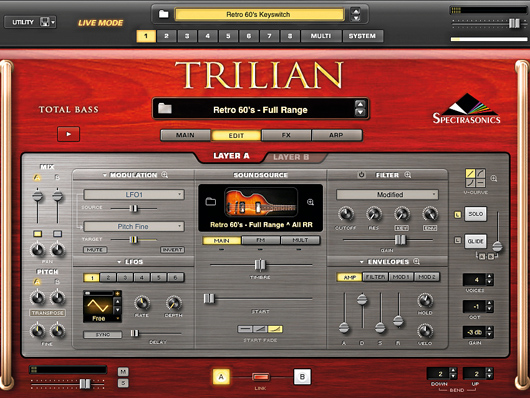MusicRadar Verdict
Trilian's not without a few quirks, but it's a fine successor to Trilogy and one of the best sources for bass sounds of all kinds.
Pros
- +
Serious processing options. Extensive bass instrument library. Easy interface considering complexity. Great synth sound sources. Custom controls.
Cons
- -
Unintuitive browser. Trilogy patches not out at time of review.
MusicRadar's got your back
Released in 2003, Trilogy was a respected bass instrument offering a good selection of synth, electric and acoustic basses, with its sibling Atmosphere being similarly famed for lush synth pads and the like.
Things move on, however, as demonstrated by Atmosphere's 2008 sequel Omnisphere - as well as a huge library of brand new sound content, this debuted the company's own sample/synthesis backbone, dubbed the Steam Engine.
Now we have the second Steam-powered instrument, Trilian, arriving to supersede Trilogy. The library is 34GB in size, and the meat of it comprises the new instruments: acoustic bass with four separate mic/pickup channels, six electric basses (including Music Man five-string, Fender Precision, Fender Jazz and Chapman Stick) and numerous synth sources, including the Yamaha CS-80, Moog Taurus, Dave Smith Tetra and ARP 2600. You also get everything from Trilogy (remastered) and, as a bonus, an enhanced version of the Bass Legends library.
Trilian's new library is not only very detailed but also sports features such as automatic legato, round robin variations, multisampled dynamic slides, phase-locked amp/DI mixing and two modes, Live and Stack, for coping with multiple articulations. Clearly, realistic bass is fundamental to Trilian's remit.
In detail
The Steam Engine offers a multitimbral structure with eight dual-layer parts, 33 effects and the ability to integrate streaming sample playback with synthesis techniques - Trilian sports FM capabilities, but it lacks the full-on DSP synth oscillators, waveshaping and granular synthesis of Omnisphere. However, the 19 stereo filter types with twin filters per layer, multipoint looping envelopes and six LFOs (with nine waveform options) mean that Trilian is still very much a synthesis heavyweight.
Totally new for Trilian are the 4-pole Juicy and Power filters with oscillating resonance. Add in the synth modulation options (26 mod sources and 47 targets), the Flex-Mod system for on-the-fly setup and the option to modulate over 200 effect parameters, and you begin to appreciate just how mighty the Steam Engine is.
"Trilian sports FM capabilities, but it lacks the full-on DSP synth oscillators, waveshaping and granular synthesis of Omnisphere."
All this power may sound daunting, but Trilian is actually very simple to use. Patches are built from one or two layers, each consisting of a 'soundsource' (essentially a multisampled polyphonic oscillator). Layers include the typical synth-esque trimmings (modulation, LFOs, envelopes and filters), as well as insert effects and arpeggiator options.
Up to eight patches can be layered in a multi, with individual level, panning, MIDI channel and auxiliary effects. For navigation, each layer has four tabbed screens (Main, Edit, FX and Arp), plus some deeper, complex pages accessed with the Zoom icon, such as the modulation matrix.
The multi view also has four screens (Mixer, FX, Live and Stack) but is a simpler affair. However, there's nothing to stop you sticking to the Main screen with its patch-specific 'custom controls'.

Sounds
Trilian's acoustic and electric basses are extremely detailed. For example, Trilogy's Double Bass instrument has four velocity layers and is 288MB, but in contrast, Trilian's Full Range Acoustic 1 has 12 velocity layers, 16 round robin alternatives per note and is 2.3GB.
As expected, there are plenty more articulations - we counted 11 basic ones for the Clean Bass (Fender Jazz) - and you also get release noises and automatic legato. Of the stringed patches, the five-string Studio (Music Man) Bass, with its clean, punchy sound, is our favourite.
Multi patches and the Live mode bring the above elements together, with the Switch option in Live mode enabling temporary keyswitching. The other keyswitching modes didn't work properly for us, though, sometimes resulting in unwanted articulations playing.
Also annoying is that patches start loading as soon as you select them in the browser - not great if you're surfing and just want to read the descriptions. Both Lite mode and Preview load can help here, luckily.
"It's obvious that Trilian's ambitions go beyond simple bass sounds, and with over 350 synth sound sources, modifying or programming from scratch is always an option."
As for the synthetic sounds, it's important that new users download the latest patch library, which includes over 500 new synth patches. Enhanced versions of the original Trilogy patches should also be out by the time you read this, although your old Trilogy presets are not compatible with Trilian. On a related note, you can also use Trilian's sounds within Omnisphere (but not the other way around).
The synth sounds are arranged in three categories: Mono, Bass and Arp + Rhythm. Sonically, there's much variety to be had, with plenty of noises and sweeps, as well as basses and rhythmic, arp-dependent patches that are often reminiscent of the original synths that were sampled. Most synth patches make great use of Trilian's effects, frequently with parameters linked to carefully configured custom controls.
It's obvious that Trilian's ambitions go beyond simple bass sounds, and with over 350 synth sound sources, modifying or programming from scratch is always an option.
Other modes
Trilian's Live and Stack modes enable you to use the instrument in a more specific multitimbral way. Stack can quickly map all of your eight parts either by velocity or key range, or switch between parts using MIDI CC (only one option can be used at a time). It overrides any MIDI allocations in the Mixer, so that all layers respond to one selected channel.

In use, it's great for spreading multiple articulations across the keyboard, building velocity-sensitive combination patches or morphing between parts.
Live is more akin to typical keyswitching territory. Again, up to eight patches can be used, and with full control over key, MIDI CC and even mouse-click assignments, it's very flexible. There are those three switching methods - Switch, Latch and Touch - that influence the nature of the switching, and with an easy MIDI learn option, as well as various ways to view assignments, it's difficult to go too far wrong.
One of the best features is that existing articulations don't cut off when you switch to another. If you use basslines with multiple articulations such as slides, mutes and so on, Live mode makes it very simple, and there are plenty of library patches that are already set up to work this way.
Summary
Trilian is an enormously powerful and deep instrument that can keep you busy for hours. Every patch, be it synth- or string-based, sounds brilliant in isolation, making it great for upfront 'lead' bass sounds; and the performance features and effects enable you to create unique and impressive tones with ease.
Our Trilian audio demo contains:
1. Trilian Acoustic 1 All patch: using Live mode to program key switches on the fly.
2. Trilian Acoustic 2 Character patch: using Live mode to program key switches on the fly.
3. Trilian Acoustic 2 Vibrato patch: more legato playing to demonstrate the vibrato articulation of this patch.
4. Studio Bass All patch: using Live mode to program key switches on the fly.
5. Studio Bass Slap patch: the classic thumping slap sound, programmed using Live mode.
6. Eight different synth patches using both Trilian and Trilogy sound sources. Making use of the custom controls on the main page and then the arp to modify the sound in real time.
Cwejman S1 + Metasonic FX
Bass Station + Metabolic
SH101 Sub + Arp2600 Square
Tetra + TB303 Square
CS80
CS80 + SH101
Arp2600 + SH101
Oberheim SEM Octobass
Computer Music magazine is the world’s best selling publication dedicated solely to making great music with your Mac or PC computer. Each issue it brings its lucky readers the best in cutting-edge tutorials, need-to-know, expert software reviews and even all the tools you actually need to make great music today, courtesy of our legendary CM Plugin Suite.
“Its mission is simple: unleash the power of any amplifier or line-level source without compromise”: Two Notes promises a “watershed” in tube amp control with the Torpedo Reload II
“I’m looking forward to breaking it in on stage”: Mustard will be headlining at Coachella tonight with a very exclusive Native Instruments Maschine MK3, and there’s custom yellow Kontrol S49 MIDI keyboard, too
“The thing from the agency said, ‘We want a piece of music that is inspiring, universal, blah-blah, da-da-da...' and at the bottom it said 'and it must be 3 & 1/4 seconds long’“: Brian Eno’s Windows 95 start-up sound added to the US Library of Congress











